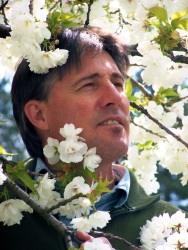 Dicentra formosa ‘Aurora’ – This pacific fernleaf bleeding heart bears plump pure white heart-shaped flowers from late spring into early summer, and often re-blooms in the fall. ‘Aurora’ may go summer dormant if allowed to go dry in the heat. This deer resistant plant is good for edging, and will bloom longer when deadheaded. Grows 12-15″ high. Zone 3.
Dicentra formosa ‘Aurora’ – This pacific fernleaf bleeding heart bears plump pure white heart-shaped flowers from late spring into early summer, and often re-blooms in the fall. ‘Aurora’ may go summer dormant if allowed to go dry in the heat. This deer resistant plant is good for edging, and will bloom longer when deadheaded. Grows 12-15″ high. Zone 3.
 Anemone nemorosa ‘Montrosa’ – Wood Anemones are great choices for flowering groundcovers and ‘Montrosa’ features large, unusual semi-double blooms of a marbled green and white that face upwards. These are borne from March to April over fresh, bright green foliage. Somewhat similar to ‘Bracteata Pleniflora’ (the latter more white in the middle). Grows 5″ high. Zone 5.
Anemone nemorosa ‘Montrosa’ – Wood Anemones are great choices for flowering groundcovers and ‘Montrosa’ features large, unusual semi-double blooms of a marbled green and white that face upwards. These are borne from March to April over fresh, bright green foliage. Somewhat similar to ‘Bracteata Pleniflora’ (the latter more white in the middle). Grows 5″ high. Zone 5.
 Brunnera macrophylla ‘Mr. Morse’ – Essentially a white-flowered version of ‘Jack Frost’, except that the green veins are more prominent. The white flowers are around for about 6 weeks in spring and contrast nicely with the silver foliage. Try this one in combination with Japanese painted fern (Athyrium niponicum ‘Pictum’). Deer resistant. Grows 12-15″ high. Zone 3
Brunnera macrophylla ‘Mr. Morse’ – Essentially a white-flowered version of ‘Jack Frost’, except that the green veins are more prominent. The white flowers are around for about 6 weeks in spring and contrast nicely with the silver foliage. Try this one in combination with Japanese painted fern (Athyrium niponicum ‘Pictum’). Deer resistant. Grows 12-15″ high. Zone 3
 Dicentra ‘Ivory Hearts’ – This hybrid cross of Dicentra peregrina and Dicentra eximia bears elegant ivory-white blooms (like little heart-shaped lockets) from April to early June. It may also flower sporadically throughout the summer and again in early autumn in coastal gardens. ‘Ivory Hearts’ features beautiful bluish-green finely cut foliage. Grows 10-12″ high by 16″ wide. Zone 3.
Dicentra ‘Ivory Hearts’ – This hybrid cross of Dicentra peregrina and Dicentra eximia bears elegant ivory-white blooms (like little heart-shaped lockets) from April to early June. It may also flower sporadically throughout the summer and again in early autumn in coastal gardens. ‘Ivory Hearts’ features beautiful bluish-green finely cut foliage. Grows 10-12″ high by 16″ wide. Zone 3.
 Anemone nemorosa ‘Green Fingers’ (syn. Green Fingers Group) – Another of the woodland anemones with bizarre white blooms (sterile) interrupted with an irregular green fringe (over a carpet of bright green foliage) from late March through to May. This Irish introduction will go summer dormant but makes a fine shade groundcover. Grows 3-5″ high. Zone 4.
Anemone nemorosa ‘Green Fingers’ (syn. Green Fingers Group) – Another of the woodland anemones with bizarre white blooms (sterile) interrupted with an irregular green fringe (over a carpet of bright green foliage) from late March through to May. This Irish introduction will go summer dormant but makes a fine shade groundcover. Grows 3-5″ high. Zone 4.
















































